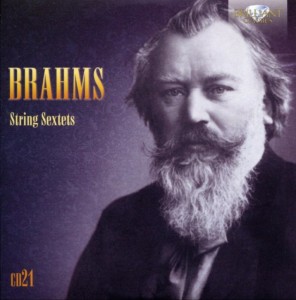 Johannes sure does love his pizzicato, the word for the plucking of stringed instruments (which, to me, always sounds like a character in a cartoon sneaking up on another character – you know, that tip-toe sound).
Johannes sure does love his pizzicato, the word for the plucking of stringed instruments (which, to me, always sounds like a character in a cartoon sneaking up on another character – you know, that tip-toe sound).
Because he uses it a lot.
So much so that its effect on me has diminished.
I used to love hearing it in a Classical composition, smiling whenever my ears would pick it out of a movement.
Now, I just think, “Must be Brahms.” Yawn.
Here’s what I’m listening to today:
String Sextet no. 1 in B flat Op. 18
Movement I (“Allegro ma non troppo”) runs the gamut from pastoral to pretentious, from melodic to mash-up. The instruments ebb and flow, sometimes building to a sound that resembles a “mash-up” video on YouTube in which someone has combined two songs into one. The ending of Movement I is all stringed instruments being plucked.
Why? I don’t know. Pizzicato is supposed to be like a caviar garnish – not a main course.
According to its entry on Wikipedia:
The String Sextet No. 1 in B-flat major, Op. 18, was composed in 1860 by Johannes Brahms. It was published in 1862 by the firm of Fritz Simrock.
The sextet is scored for two violins, two violas, and two cellos.
There are earlier examples by Luigi Boccherini (two sets of six each). However, between the Boccherini and the Brahms, very few for stringed instruments without piano seem to have been written or published, whereas within the decades following Brahms’ two examples, a number of composers, including Antonín Dvořák, Peter Ilyich Tchaikovsky, Joachim Raff, Max Reger, Arnold Schoenberg, and Erich Wolfgang Korngold, all wrote string sextets.
This sextet was used as soundtrack by French director Louis Malle in the movie “The Lovers” (“Les Amants”, 1958).
The sextet’s second movement is featured in the Star Trek: The Next Generation episode “Sarek”. The second movement is featured in “The Day of the Dead”, an episode of Inspector Morse.
Movement II (“Andante, ma moderato”) is actually very, very interesting. In fact, it’s one of my favorite movements in all of the Brahms I’ve heard to date. It’s melodic and compelling and moving. A Favorite!
Wow. I didn’t know Johannes had it in him.
NOTE: Movement II does get a bit busy again about midway through. It sounds like the cello and viola are playing music that reminds me of waves or wind, while the violins are playing strains of the initial melody. Then, it quiets again and becomes emotional and melodic. About 3/4 through, it becomes more somber, features more pizzicato, and sounds even more soundtrack-like.
No doubt about it. Movement II is a terrific piece of music. I think it’s even share-worthy.
Brahms was 27 when he composed Sextet No. 1.
String Sextet No. 2 in G Op. 36
According to its entry on Wiki:
Johannes Brahms’ String Sextet No. 2 in G major, Opus 36 was composed during the years of 1864-1865 and published by the firm of Fritz Simrock. It was first performed in Boston, Massachusetts on October 11, 1866. The work is scored for two violins, two violas, and two celli, and has four movements…
Brahms did most of the composition in the comfortable country surroundings of Lichtental, near Baden-Baden. According to Brahms’ biographer Karl Geiringer, it conceals a reference to the first name of Agathe von Siebold (with whom he was infatuated at the time) in the first movement, bars 162-168, with the notes a-g-a-d-h-e.
The work is characterised by its exotic sounding opening of the first movement, by innovative chord structures and its many contrasts both technical and melodical.
Yes. String Sextet No. 2 is also quite good. It opens in such a way that I’m drawn in.
Brahms was 32 when he completed this sextet.
Here are the musicians on today’s CD:
Alberni Quartet
Howard Davis violin
Peter Pople violin
Berian Evans viola
David Smith cello
Roger Best viola
Moray Welsh cello
I know there are hardcore Brahms fans out there. But I don’t know why. His music – although more appealing to me than Haydn’s – doesn’t sound unique. Frankly, it doesn’t sound like anything at all. It’s more technical than melodic to my ears. In that regard, Brahms seems to be more for the music nerd, the intellectual analyzer of Classical music, the people who can point to a passage of music and say, “Did you hear that? It was a C sharp in conjunction with a C! The tension between the two indicates…”
I like doing that with progressive rock. I’ll analyze something Yes composed, listening with keen ears to Chris Squire’s bass line, picking out and sharing a cleverness I discovered. So I get it. I understand music nerds having an eargasm over Brahms’ technical prowess. I get it. But at least with Yes and all their technical prowess, they still composed music with melody that I could get into from start to finish. Brahms…not so much.
In the last three weeks – 21 full days – I’ve only encountered, maybe, 40-50 minutes of Brahms’ music that bowled me over, caused me to sit up and take notice, want to play it again – especially for someone else, which is the real test for me.
